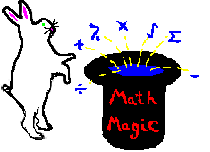

A. There are several different ways of solving two equations with two variables. This page will focus on only two ways:
1. Substitution Method
2. Elimination Method
B. Substitution Method
1. This method works under the assumption that you can solve for one variable (in terms of another) and plug this value into the other equation and solve.
Ex [1] If 2x + y = 5 and 3x + 2y = 9, then x = ___.
a. In this problem, the 1st equation has a single 'y' so we can solve for y and get y = 5 - 2x. Now we can substitute this value into the 2nd equation.
b. Doing so gives 3x + 2(5 - 2x) = 9. Now we have an equation with one variable so we can solve for x. This yields: 3x + 10 - 4x = 9 or x = 1.
c. The answer is 1. If the problem had wanted the y-value, you substitute x =1 for one of the equations and solve for x. 2(1) + y = 5. So y = 3.
C. Elimination Method
1. To use this method, you will have to "eliminate" one of the variables by adding the equations together. Sometimes you have to multiply one equation by a constant to get the same coefficient (but they must have opposite signs) so they will cancel each other out.
Ex [1] If 3x + 2y = 4 and -6x + 3y = 6, then y = ___.
a. In this equation, we can eliminate the x variable if we multiply the first equation by 2 and add it to the second equation.
b. So multiplying the 1st equation by 2 gives: 6x + 4y = 8. Now we can add the two equations together and get 7y = 14 or y = 2.
c. The answer is 2. If the question had asked for the x value we could plug y=2 into one of the equations and solve for x. 3x + 2(2) = 4 or 3x = 0 or x = 0.
D. Sometimes the problem can be solved much easier if the 2nd equation is a multiple of the first.
Ex [1] If 2x - 3y = 4 then 6x - 9y = ______
a. This problem is a little different from the ones above, but is much easier. If you notice the 2nd equation is 3 times the 1st. That means the answer is 3 x 4 or 12.